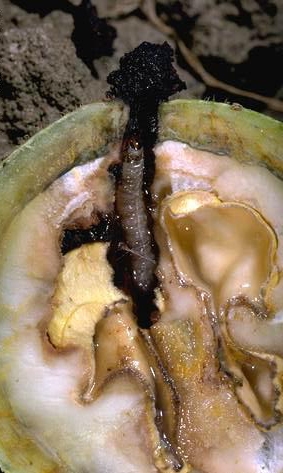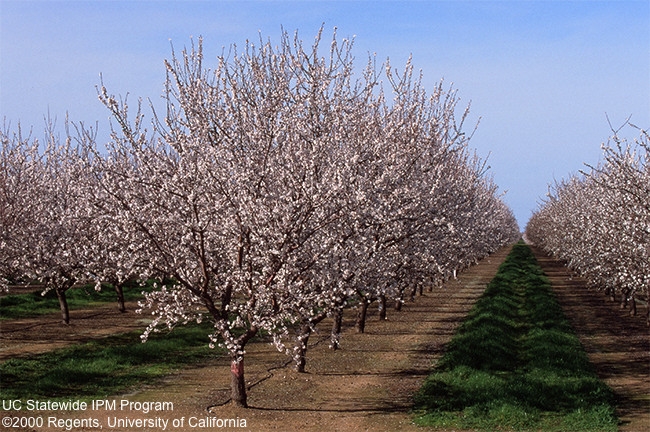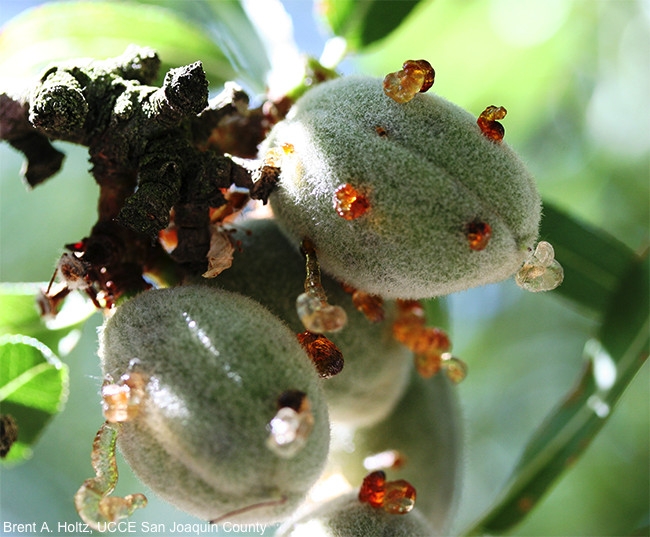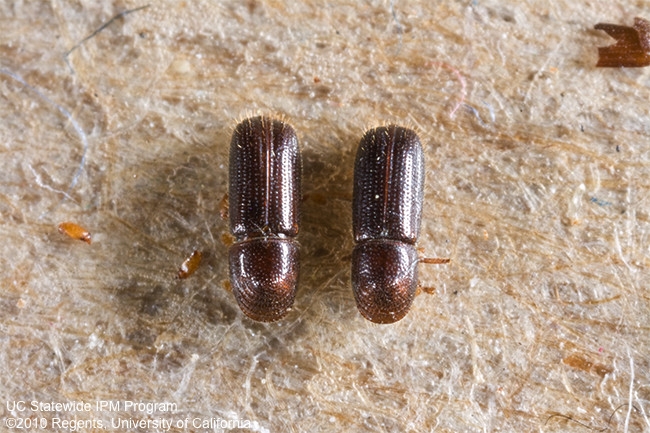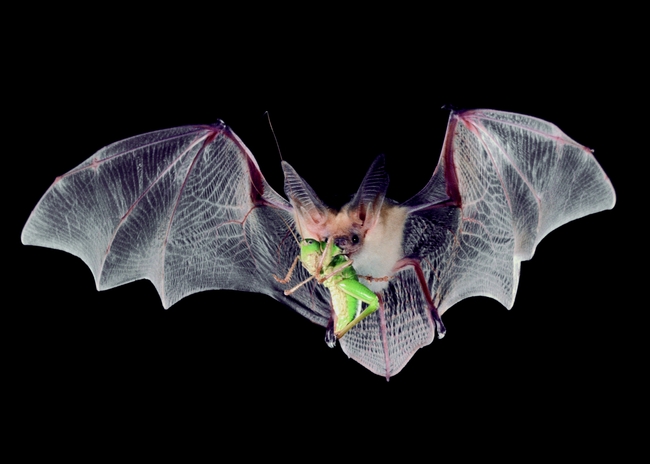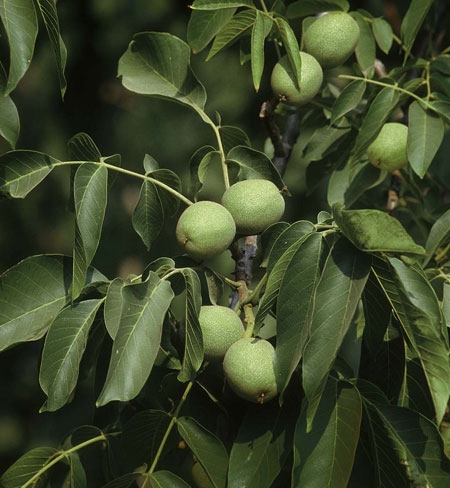Posts Tagged: Walnuts
New $1 million research project to test mating disruption for pest control in walnuts
The Community Alliance with Family Farmers and UC Cooperative Extension are working with farmers to establish six demonstration sites in walnut orchards that will examine the effectiveness of mating disruption to control two major pests of the crop – codling moth and navel orangeworm.
The three-year research effort is funded with a $1 million award from the California Department of Agriculture Biologically Integrated Farming Systems program.
“The project sites will be in the Sacramento and northern San Joaquin Valleys, but we expect the demonstration to be of interest to walnut farmers across the state,” said Sara Tiffany, CAFF director of ecological farming and the project lead. “Farmers who grow related crops, like almonds and pistachios, will also be able to benefit from the findings.”
Over the past 55 years, conventional walnut farmers have often turned to the broad-spectrum pesticide chlorpyrifos – commonly known by the trade name Lorsban – to protect the crop from codling moths and navel orangeworm. However, California regulators have determined it may no longer be used in the state as of Dec. 31, 2020.
“Farmers need alternatives. In this project, we will be studying the effectiveness of alternatives that already exist,” said Jhalendra Rijal, UC Cooperative Extension integrated pest management advisor for San Joaquin, Stanislaus and Merced counties, the lead scientist on the project. The California Walnut Board is also part of the project team.
Six farmers will be recruited to enroll at least 80 acres each in the demonstrations – three farmers in the Sacramento Valley and three in the northern San Joaquin Valley. The entire acreage will be managed following UC IPM guidelines for walnut production, including cover crops, reduced risk pesticide options and biological control.
Forty acres will be treated with commercially available mating disruption products, while the other 40 acres will not. The treatment works by confusing the pests. Codling moth and navel orangeworm moths naturally release pheromones that help them find mates. The female lays eggs in the immature nuts, and when they hatch, the larvae feed on the nuts, rendering them unmarketable. In the treated area, the orchards will be flooded with a synthetic pheromone that makes it much more difficult for male and female pests to hone in on one another.
Besides codling moth and navel orangeworm, the project will systematically look at the effects of cover crops and predatory mite release on pest mite populations, and improvement in other natural enemy populations in walnut orchards.
The results of the IPM practices will be shared widely with growers, pest control advisors and certified crop consultants in articles, meetings and field days.
“Currently the use of mating disruption in walnuts is significantly lower than in almonds,” said Rijal, who is also the associate director for Agricultural IPM with the UC Statewide IPM Program. “We believe when farmers see the results of using mating disruption, along with other sustainable walnut production practices, we will improve the adoption rate.”
Birds are beneficial too!
Across the globe, scientists have shown that birds can be farmer allies. Insectivorous birds feed on damaging insect pests in many crops including coffee, cacao, oil palm, corn, cabbage and apples. Raptors, including hawks and barn owls, feed on rodents, including gophers, voles and mice (see blog, Barn owls help clean up rodents naturally).
Despite this deep historic knowledge that birds are important predators of crop pests, over time the perception of birds as natural enemies of pests has been generally replaced with the idea that birds are often major crop pests themselves. Indeed, some bird species — like some types of insects — can cause trouble for farmers, but many others — especially those that eat insects and rodents — can be beneficial.
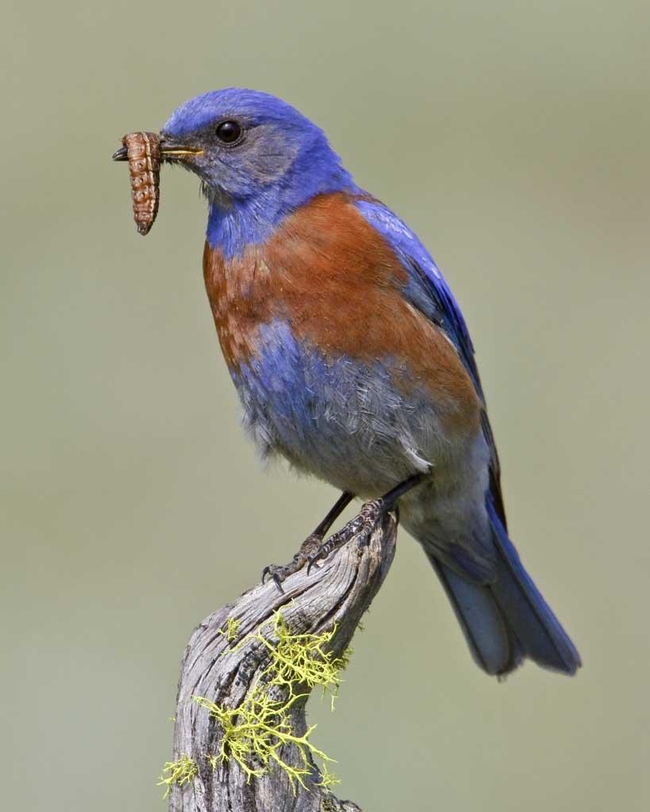
Do birds control insect pests on farms in California's Central Valley?
They do! Recent studies by Dr. Sacha Heath, UC Davis, and Rachael Long, field crops and pest management advisor, UC Cooperative Extension, showed that birds help control insect pests in walnut orchards. Dr. Sara Kross (UC Davis postdoctoral alumnus, now with Columbia University) showed that birds help control alfalfa insect pests.
Birds are voracious predators of codling moth pests in walnuts
Codling moth is a major worm-like pest that infests walnuts, apples and pears. The larvae go dormant during winter, living in cocoons in crevices in trees. Adult moths emerge in the spring, lay eggs and infest crops.
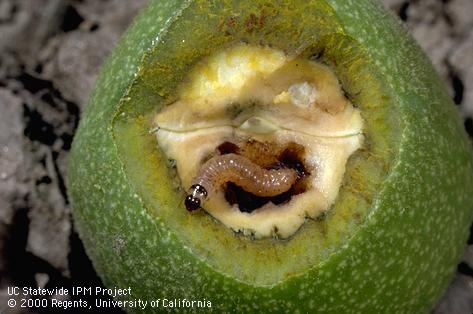
We evaluated bird predation of codling moth using “sentinel prey” and exclosure cages. We glued codling moth cocoons to walnut trunks and covered them with cages, allowing insects and spiders to access the cocoons, but not bird predators. This allowed us to count how many larvae were eaten inside and outside of the cages to estimate pest reduction by birds.
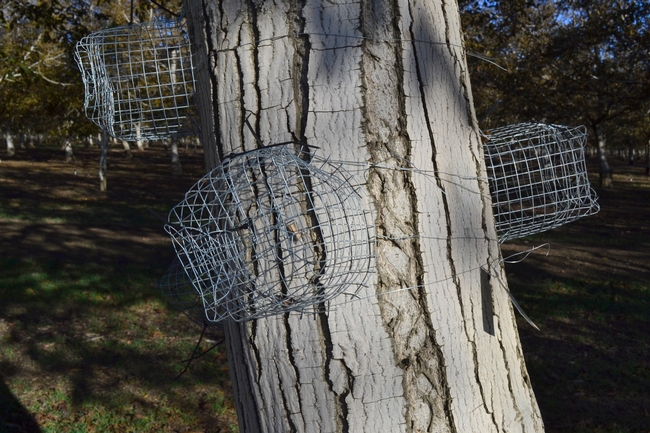
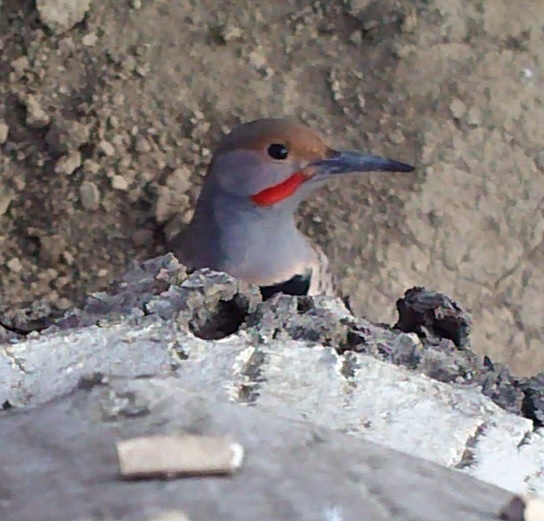
What did we find?
Natural enemies, like parasitic wasps and lacewings, alone reduced codling moth larval numbers by 11%; adding birds into the pest control system reduced them by 46%! Nuttall's woodpeckers and white-breasted nuthatches did a lot of the work; these birds travel up and down the trunks of trees, searching for insects.
Above, a white-breasted nuthatch preys on a codling moth larva “sentinel cocoon” on a walnut tree. Video by Sacha Heath.
Alfalfa weevils are no match for insectivorous birds
Alfalfa weevils are key pests of alfalfa, reducing yields and hay quality if left uncontrolled. Dr. Sara Kross looked at bird predation of this pest by excluding birds from alfalfa plants via cages, and counting the number of weevils inside and outside the cages. She found that birds reduced the number of weevils by more than 30%, showing their importance in helping to protect alfalfa from this serious pest.
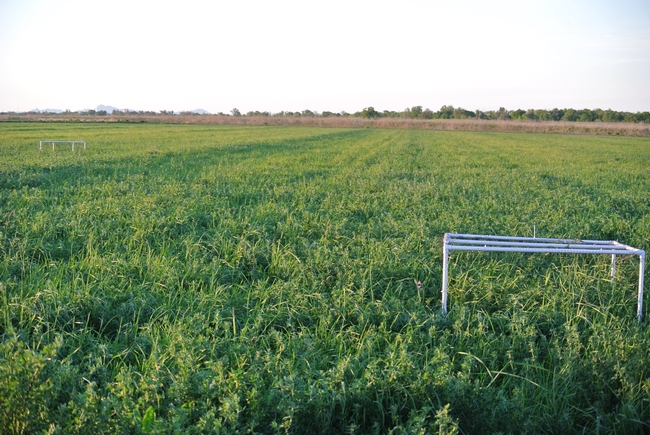
Does field edge habitat, like hedgerows, help attract beneficial birds?
Yes! Hedgerows are important habitat for beneficial birds, serving as nesting, foraging and roosting sites. In a study in the Sacramento Valley, crop margins with hedgerows, tree lines and riparian buffers harbored up to six times more birds and up to three times more bird species than bare or weedy margins.
Walnut orchards adjacent to hedgerows and riparian areas had higher numbers of beneficial birds along with more species. In alfalfa, there were more beneficial birds in fields when at least two tall trees were present along the field edges. More beneficial birds were associated with better pest control, that is, fewer codling moth cocoons and alfalfa weevils.
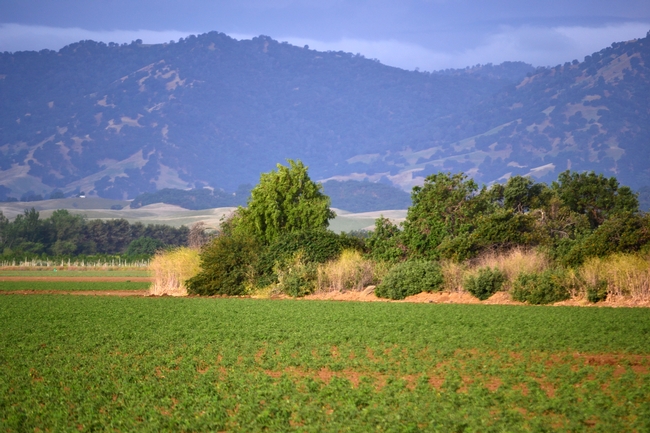
Birds have large territories, fly long distances, and are influenced by what happens on the farm as well as by what happens in the landscape around the farm. For example, we found that codling moth predation by birds greatly increased in walnut orchards as the amount of habitat in the landscape around the orchards increased (including hedgerows, tree lines, riparian and oak woodlands, and grasslands).
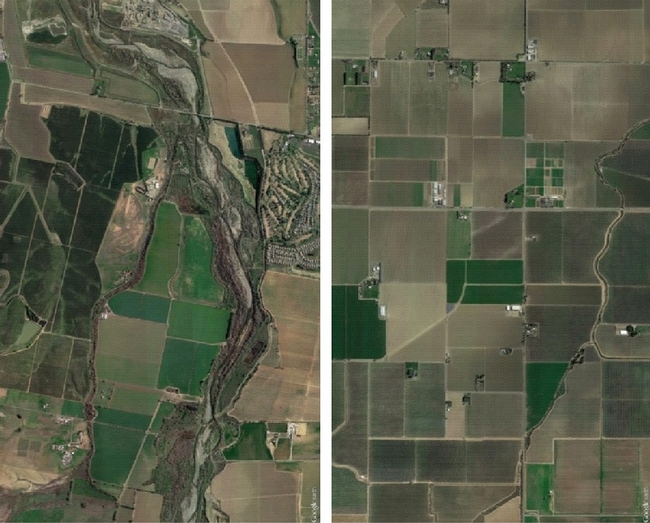
Will hedgerows increase the numbers of pest birds?
Pest birds are present on farms regardless of field edge habitat (such as weedy vegetation or hedgerows). Cases will be different, depending on the crop, but in the fields and orchards of Yolo County, researcher Hillary White (formerly with UCCE and now with U.S. Fish and Wildlife) found that three of the most common avian crop pests (American crow, red-winged blackbird and Brewer's blackbird), were up to 10 times more abundant in agricultural fields with bare or weedy margins than in fields with hedgerows.
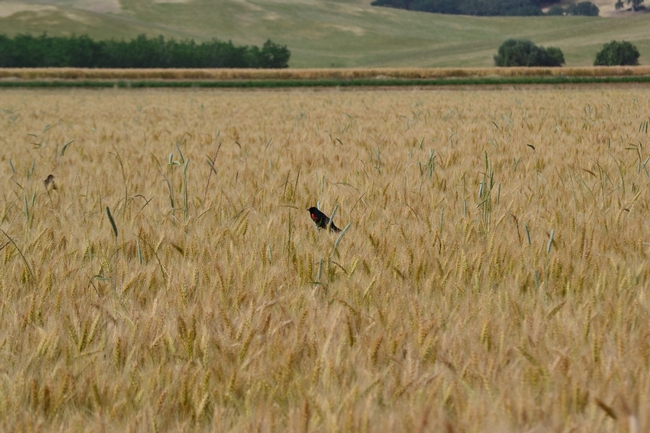
What can I do to attract beneficial birds to my farm?
Our avian research team has been quantifying the conditions under which birds are helpful or harmful to growers. We are looking for ways to help farmers create bird habitat on their farms to harness the beneficial pest control services birds can provide, while also protecting crops from the damaging effects of some bird species. This information is available in the new publication “Supporting Beneficial Birds and Managing Pest Birds,” co-authored by the Wild Farm Alliance and Drs. Kross and Heath, and technically advised by UC Cooperative Extension and several farmers. This is a user-friendly guide for farmers and conservation practitioners, with the goal of co-managing farmlands for biodiversity and farming.
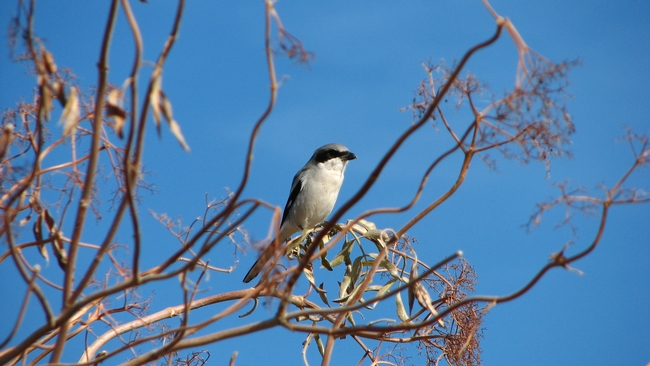
Dr. Sacha Heath received her PhD from UC Davis's Graduate Group in Ecology and will soon be starting a postdoctoral fellowship with the Living Earth Collaborative in St. Louis, Missouri.
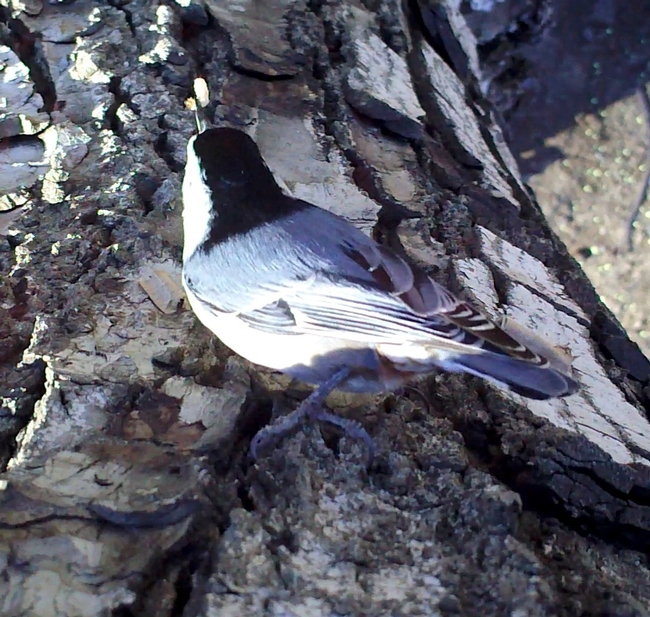
A white-breasted nuthatch preys on a codling moth larva “sentinel cocoon” on a walnut tree. (Video still: Sacha Heath)
Check out the Revised Almond and Walnut Pest Management Guideline
Writer/editor Cheryl Reynolds at UC Integrated Pest Management, just published this fantastic blog on the Revised Almond and Walnut Pest Management...
Almond and Walnut Pest Management Guidelines revised just in time for the holidays
‘Tis the season for baking lots of tasty treats. Breads, cookies, cakes, and candy are just a few that come to mind. What makes many of these treats so tasty is the addition of almonds or walnuts to the list of ingredients.
In California, we are lucky to be at the center of almond and walnut production. According to the California Department of Food and Agriculture's (CDFA's) latest Agricultural Statistics Review, more than 99 percent of the almonds and walnuts produced in the United States are grown in California.
Almond and walnut growers work tirelessly to supply enough nuts to not only satisfy domestic demand, but also for export. Worldwide, almonds rank as the largest specialty crop export. California is the top almond producer in the world, accounting for about 80 percent of all almonds grown. For walnuts, California ranks as the second largest producer in the world. To keep up with this demand, almond and walnut growers must be constantly aware of pests, diseases, and abiotic problems that can affect the tree and growing nuts.
The University of California Statewide Integrated Pest Management Program (UC IPM) has recently published revised Pest Management Guidelines for almonds and walnuts, helping growers prevent and manage pest problems with the most up-to-date information.
Revisions in the Almond Pest Management Guidelines include:
- A new section on bacterial spot, a new disease of almond in California found in the Sacramento and northern San Joaquin valleys
- A renamed section on fruit russeting, revised from the old powdery mildew section
- Significant revisions made to the management section of navel orangeworm, one of the major pests attacking California almonds
- Improvements on how to do dormant spur sampling section with easier-to-understand information on monitoring and thresholds
Revisions in the Walnut Pest Management Guidelines include:
- Updated information on the association between walnut twig beetle and thousand cankers disease
- New sections for Botryosphaeria and Phomopsis cankers, branch wilt, and paradox canker
- Significant changes to the walnut husk fly management section
Both the almond and walnut revised Pest Management Guidelines also include updated information on fungicide efficacy, weed management, and vertebrate management.
Authored by University of California specialists and advisors, the Pest Management Guidelines are UC's official guidelines for monitoring and managing pests in California crops. For more information on pest management in these or other crops, visit the UC IPM website.
Bats in the belfry? No, bats in walnut orchards
Bats are voracious predators of night-flying insects that target California crops. Research statistics show that a pregnant or nursing female can consume as much as two-thirds of her body weight in insects per night. That's somewhat like a 150-pound man eating 100 pounds of food per day.
What's the economic value of bats to the agricultural pest control? It probably exceeds $23 billion per year, according to recent studies. However, very little data exists on the benefits of bats for individual crops, such as walnuts.
UC Agriculture and Natural Resources researchers, together with UC Davis, are launching a survey to better understand the value of bats (and birds) on managed lands. The voluntary survey, focused on growers and landowners in California's Central Valley, may be completed online.
Work is already underway to assess the pest-control impact of bats on walnut production in the Central Valley with a grant from the U.S. Environmental Protection Agency STAR (Science to Achieve Results).
California produces almost all of the nation's walnuts. Farmers grow some 500,000 tons of walnuts on 290,000 acres, with the annual crop valued at $1.8 billion. Due to popular demand, new orchards are planted every year, calling for more intensive farming practices to manage costly crop pests. For walnuts, the key pest is the codling moth, a larva that feeds on developing nuts. The adult moths begin to fly and lay eggs on the nutlets in May and produce up to four generations per year.
Growers, as part of their pest control management practices, typically use insecticides, spraying once or twice a year for this pest. Many also use pheromones, a mating-disruption technology that prevents males from finding females. Although generally effective, pesticides are expensive and they can have harmful impacts on the environment.
Bats forage in walnut orchards for codling moths and other insects. Colonies of bats double their activity on farms when they roost in bat houses attached to barns in the orchards. The Mexican free-tailed bat is the most abundant species, followed by the Yuma and California myotis, and five other species, including the pallid bat.
In an effort to quantify the economic impact of bats' consumption of codling moths, we captured 36 Mexican free-tailed bats over a three-night period in an 80-acre walnut orchard in Yolo County. Some 3,000 bats live in the bat houses in an abandoned shop on the property.
The research procedure: We opened our mist net from 11 p.m. to 2 a.m. to correspond with codling moth flights and bat activity, and captured the bats as they returned to the roost after feeding. We placed the bats individually in sterile cloth sacks and kept them there until they defecated, then we released them. We quickly froze the guano pellets and shipped them to a USDA lab, where scientists genetically tested them for the presence of codling moths.
Our preliminary data suggest that 5 percent of these bats – about 150 bats from this colony of 3,000 – consumed at least one codling moth per night. We calculated 30 nights per generation for the codling moth, and four generations per year, with each female moth laying 60 viable eggs on individual nuts.
For a typical 80-acre walnut orchard producing a total of 136 tons of walnuts per year, we estimate that bats can protect about 6 percent of the crop yield, or $29,700 worth of walnuts per season at the current price of $1.65 per pound. That's an economic value of $10 per bat per year. And that figure probably underestimates the true value, since for some species of bats, up to 40 percent of their diet can consist of moths – an average of about 15 moths per night.
The next steps: we are refining our economic data and determining whether these insect-hunting bats help reduce pesticide use in walnut orchards.
Bats provide these pest control services for free while farmers enjoy a decrease of pests in their orchards and an increase in profits.
Co-authors: Rachael Long, UC ANR advisor; and Katherine Ingram, Department of Wildlife, Fish and Conservation Biology, UC Davis.


